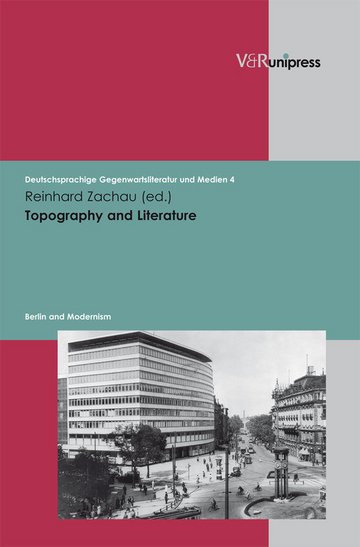Topography and Literature
Berlin and Modernism

| Verlag | Vandenhoeck & Ruprecht |
|---|---|
| Erscheinungsjahr | 2009 |
| Seitenanzahl | 187 Seiten |
| ISBN | 9783862340590 |
| Format | |
| Kopierschutz | Wasserzeichen/DRM |
| Geräte | PC/MAC/eReader/Tablet |
| Preis | 39,99 EUR |

| Verlag | Vandenhoeck & Ruprecht |
|---|---|
| Erscheinungsjahr | 2009 |
| Seitenanzahl | 187 Seiten |
| ISBN | 9783862340590 |
| Format | |
| Kopierschutz | Wasserzeichen/DRM |
| Geräte | PC/MAC/eReader/Tablet |
| Preis | 39,99 EUR |

Gehard Ernst is Professor emeritus at the Universität Regensburg, Germany. Martin-Dietrich Glessgen is Professor at the Universität Zürich, Switzerland. Christian Schmitt…

Gehard Ernst is Professor emeritus at the Universität Regensburg, Germany. Martin-Dietrich Glessgen is Professor at the Universität Zürich, Switzerland. Christian Schmitt…

This volume presents a collection of original papers at the intersection of philosophy, the history of science, cultural and theatrical studies. Based on a series of case studies on the 17th…

This volume presents a collection of original papers at the intersection of philosophy, the history of science, cultural and theatrical studies. Based on a series of case studies on the 17th…

This volume presents a collection of original papers at the intersection of philosophy, the history of science, cultural and theatrical studies. Based on a series of case studies on the 17th…

Namhafte Autoren aus Praxis und Wissenschaft liefern hier erstmalig die umfangreiche Darstellung und Analyse der Perspektiven von Publikumszeitschriften im heutigen Wettbewerbsumfeld:…

Namhafte Autoren aus Praxis und Wissenschaft liefern hier erstmalig die umfangreiche Darstellung und Analyse der Perspektiven von Publikumszeitschriften im heutigen Wettbewerbsumfeld:…

Namhafte Autoren aus Praxis und Wissenschaft liefern hier erstmalig die umfangreiche Darstellung und Analyse der Perspektiven von Publikumszeitschriften im heutigen Wettbewerbsumfeld:…

Namhafte Autoren aus Praxis und Wissenschaft liefern hier erstmalig die umfangreiche Darstellung und Analyse der Perspektiven von Publikumszeitschriften im heutigen Wettbewerbsumfeld:…

Akademie Studienbücher - Literaturwissenschaft - Diskussion von Epochenbegriff und Epochengrenzen - Autor, Markt und Publikum: Strukturwandel der literarischen Öffentlichkeit - Die…

Seit 1975 fördert die ›Allgemeine Zeitschrift für Philosophie‹ mit jährlich drei Heften den professionellen Gedankenaustausch aller am philosophischen Denken Interessierten. Inhaltlich ist die ...

Medizin und Gesundheit Aktuell zu Konzepten, Forschung, Therapie, Diagnostik und Klinik Seit April 1991 erscheint regelmäßig eine monatliche Fachzeitschrift für den jungen niedergelassenen ...

BIBEL FÜR HEUTE ist die Bibellese für alle, die die tägliche Routine durchbrechen wollen: Um sich intensiver mit einem Bibeltext zu beschäftigen. Um beim Bibel lesen Einblicke in Gottes ...

Auflagenstärkste deutschsprachige Bonsai-Zeitschrift, basierend auf den renommiertesten Bonsai-Zeitschriften Japans mit vielen Beiträgen europäischer Gestalter. Wertvolle Informationen für ...

aktuelle Berichte zum Thema Burgen, Schlösser, Wehrbauten, Forschungsergebnisse zur Bau- und Kunstgeschichte, Denkmalpflege und Denkmalschutz Seit ihrer Gründung 1899 gibt die Deutsche ...

Das Hauseigentum. Organ des Landesverbandes Haus & Grund Brandenburg. Speziell für die neuen Bundesländer, mit regionalem Schwerpunkt Brandenburg. Systematische Grundlagenvermittlung, viele ...

Prüfungs- und Praxiswissen für Ihre Ausbildung. Mehr Erfolg in der Ausbildung, sicher in alle Prüfungen gehen, im Beruf jeden Tag überzeugen: „Die Kaufleute für Büromanagement“ ist die ...

Bau und Einsatz von Werkzeugmaschinen für spangebende und spanlose sowie abtragende und umformende Fertigungsverfahren. dima - die maschine - bietet als Fachzeitschrift die Kommunikationsplattform ...

Die Flugzeuge der Bundeswehr, Die F-40 Reihe behandelt das eingesetzte Fluggerät der Bundeswehr seit dem Aufbau von Luftwaffe, Heer und Marine. Jede Ausgabe befasst sich mit der genaue Entwicklungs- ...

filmdienst.de führt die Tradition der 1947 gegründeten Zeitschrift FILMDIENST im digitalen Zeitalter fort. Wir begleiten seit 1947 Filme in allen ihren Ausprägungen und Erscheinungsformen. ...